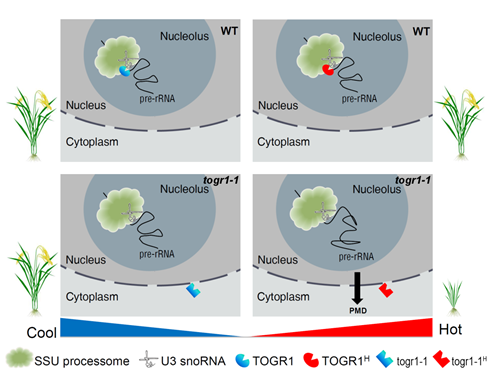Global warming has caused significant reduction in worldwide crop yields and most likely the damage level will keep rising in future. On the other hand, plants as sessile organisms are known to adopt multiple strategies to protect their growth from heat stress. Nevertheless, the molecular mechanisms of thermotolerance remain largely obscure.
Ribosomal RNA homeostasis is known to be critical for plant cell growth. RNA chaperones including RNA helicases secure a correct RNA conformation during its metabolism and are widely involved in diverse cellular processes. It has been well documented that many members of them protect RNA from cold stress in bacteria, yeast and plants, but little is known about their roles in thermotolerance. Rice encodes a large family of RNA helicases, suggesting they could contribute to plants’ adaptive growth in a diverse range of abiotic stress tolerances.
Collaborated research from XUE Yongbiao’s lab and CHENG Zhukuan’s lab, both from the Institute of Genetics and Developmental Biology, Chinese Academy of Sciences, identified a novel gene, Thermotolerant Growth Required1 (TOGR1) from a thermosensitive rice mutant (togr1-1). It encodes a DEAD-box RNA helicase and confers thermotolerant growth as an intrinsic rRNA chaperone by maintaining rRNA homeostasis under heat stress.
Consistently, its RNA unwinding activities is elevated in response to a shift to high temperature and its expression is tightly coupled to daily temperature fluctuations and the circadian clock. Their study shows that TOGR1 is specifically recruited to the small subunit (SSU) pre-rRNA processome in the nucleolus and ensures an effective rRNA processing required for a proper primary metabolism and a normal cell proliferation under heat stress. Furthermore, natural variation in its transcript level is positively correlated with plant height and its overexpression significantly improves rice growth under hot conditions.
This study reveals a novel molecular link between rRNA homeostasis and plant thermotolerance and sheds a new light on the roles of RNA chaperones during heat stress tolerance of plants. It also provides a possibility to produce heat-tolerant crops by regulating the expression of TOGR1 and its orthologs.
This work entitled “Nucleolar DEAD-Box RNA Helicase TOGR1 Regulates Thermotolerant Growth as a Pre-rRNA Chaperone in Rice” has been published online in
PLoS Genetics (
doi:10.1371/journal.pgen.1005844).
Fig. Being recruited to the SSU in the nucleolus by U3 snoRNA, TOGR1 serves as a pre-rRNA chaperone in a temperature-dependent manner and protects pre-rRNA processing from high temperature. TOGR1H and togr1-1H represent proteins with elevated activities in response to temperature increase. (Image by IGDB)
Contact:
XUE Yongbiao
Email: ybxue@genetics.ac.cn
 Fig. Being recruited to the SSU in the nucleolus by U3 snoRNA, TOGR1 serves as a pre-rRNA chaperone in a temperature-dependent manner and protects pre-rRNA processing from high temperature. TOGR1H and togr1-1H represent proteins with elevated activities in response to temperature increase. (Image by IGDB)Contact:XUE YongbiaoEmail: ybxue@genetics.ac.cn
Fig. Being recruited to the SSU in the nucleolus by U3 snoRNA, TOGR1 serves as a pre-rRNA chaperone in a temperature-dependent manner and protects pre-rRNA processing from high temperature. TOGR1H and togr1-1H represent proteins with elevated activities in response to temperature increase. (Image by IGDB)Contact:XUE YongbiaoEmail: ybxue@genetics.ac.cn CAS
CAS
 中文
中文




.png)
